Illegal gold mining, the pulp and paper industries, climate change, and forest fires are also impacting orangutan populations.
In Indonesia, mining operations have contributed to 10% of the total environmental damage to the nation's forests and, perhaps more so than any other type of forest conversion, have the greatest impact on the landscape. The open-pit method of mining used in Indonesia, most often for gold or silica, turns lush rainforest into a barren, lifeless moonscape, where nothing can survive, and, although Indonesian law No 41 of 1999 prohibits such mining in protected forest areas, it is thought 90% of open-pit mines are located in protected areas.
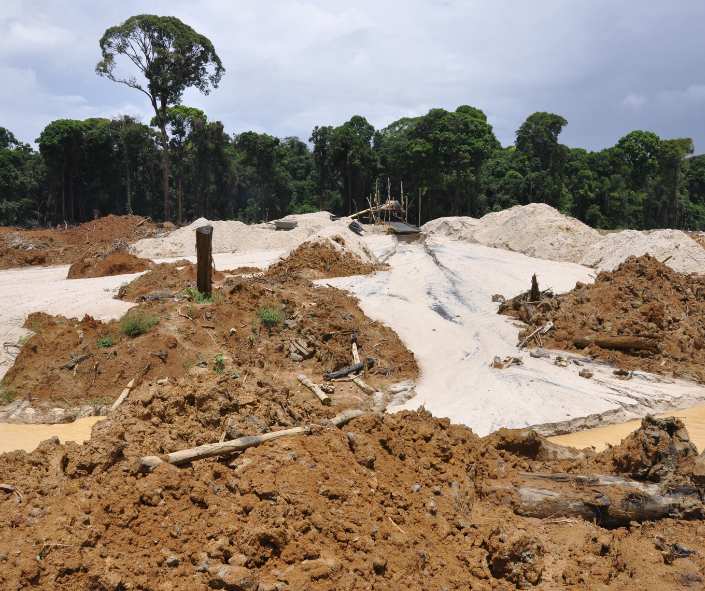 In addition to the devastating loss of biodiversity, soil erosion and runoff from open-pit mining has caused normally transparent blackwater rivers to run a muddy, opaque brown, and of great concern are the long-lasting effects of some of the chemicals used in the mining process. Despite being illegal in Indonesia, mercury is often used to extract gold, and contamination of rivers and water sources by this chemical can have a disastrous effect on fish stocks and human health. Anecdotal data from a village in central Kalimantan suggests fish stocks decreased by 70% in areas near to mercury using gold mines, and studies have shown exposure to high levels of mercury can damage the human immune system. Despite this, Indonesia ranks second to China in the use of mercury in gold mining.
In addition to the devastating loss of biodiversity, soil erosion and runoff from open-pit mining has caused normally transparent blackwater rivers to run a muddy, opaque brown, and of great concern are the long-lasting effects of some of the chemicals used in the mining process. Despite being illegal in Indonesia, mercury is often used to extract gold, and contamination of rivers and water sources by this chemical can have a disastrous effect on fish stocks and human health. Anecdotal data from a village in central Kalimantan suggests fish stocks decreased by 70% in areas near to mercury using gold mines, and studies have shown exposure to high levels of mercury can damage the human immune system. Despite this, Indonesia ranks second to China in the use of mercury in gold mining.
One of the biggest drivers of forest loss in Malaysia and particularly Indonesia has been the expanding pulp and paper market.
The pulp and paper industry in Indonesia, which supplies products including toilet paper and printer paper to the world export market, is dominated in Indonesia by two companies, Asia Pulp and Paper and APRIL, which control 75% of the market. The capacity of pulp mills in Indonesia in 1990 was 1 million tonnes a year, which had risen to 5.9 million tonnes a year by 2001. It is estimated that the industry had destroyed 835,000 hectares of high conservation forest by 2000 in Sumatra alone, and there are plans by the government to expand pulp and paper plantations by 5 million hectares over the coming decade (Pulp Mill Watch, 2007).
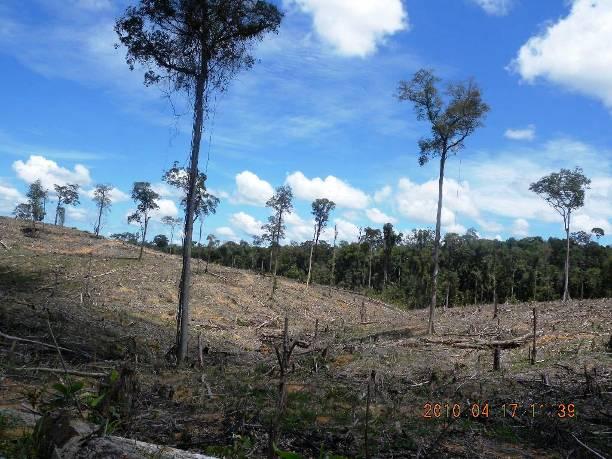 Like the palm oil industry, the pulp and paper industry in Indonesia has been riddled with corruption and has been the subject of vociferous criticism over the years regarding its impact on the environment, on endangered species such as the orangutan and particularly its appalling human rights abuses against the indigenous forest-dwelling tribes of Indonesia.
Like the palm oil industry, the pulp and paper industry in Indonesia has been riddled with corruption and has been the subject of vociferous criticism over the years regarding its impact on the environment, on endangered species such as the orangutan and particularly its appalling human rights abuses against the indigenous forest-dwelling tribes of Indonesia.
Helping individual animals is critical to the survival of the orangutan. But at its heart, conservation hinges on protecting the habitats and ecosystems that both animals and humans depend on.
The Earth contains a vast network of ecosystems that control and stabilize everything on our planet. Here are just a few things that ecosystems regulate:
Forests might be the most important ecosystems, both for us and for orangutans. As large primates who feed chiefly on fruit and live only in the lowland tropical rainforests of Borneo and Sumatra, their survival relies on the future of Asia’s tropical rainforests. Although studies suggest that orangutans can survive in degraded and disturbed tropical rainforest (Ancrenaz et. al., 2007), they simply cannot survive in any other type of ecosystem.
 Forests are also vital for the role they play in regulating water resources. During downpours, the vegetation catches raindrops that would otherwise fall on the ground. By intercepting rainfall and decreasing the speed with which it hits the ground, forests reduce the risk of flooding.
Forests are also vital for the role they play in regulating water resources. During downpours, the vegetation catches raindrops that would otherwise fall on the ground. By intercepting rainfall and decreasing the speed with which it hits the ground, forests reduce the risk of flooding.
Forest ecosystems alone regulate a third of the planet’s watersheds, on which nearly five billion people depend (Millennium Ecosystem Assessment, 2005). Despite covering just 6% of the world’s surface, tropical rainforests receive nearly half of the world's rainfall. In southeast Asia, an intact, old-growth tropical forest intercepts at least 35% of all rainfall, while a palm oil plantation will intercept just 12% (Ba, 1977). Extensive flooding in Kalimantan over the last few years has been attributed to the conversion of primary rainforest to palm oil plantations (Jakarta Post, 2008). A 10% decrease in forest cover in developing countries would lead to a flood frequency increase of between 4% and 28% (Bradshaw et al, 2007). Studies also show that the impact of the 2004 tsunami, which ravaged areas of Indonesia, Thailand, and Sri Lanka, would have been less if the hardest-hit areas weren't stripped of their mangrove forests, which act as buffers against floods and rising water levels (Dahdouh-guebas et al, 2005). Protection against rising water levels is extremely important. While the Tripa peat swamps in northern Sumatra serve as a freshwater reservoir for local people, they also saved countless lives during the tsunami by acting as a buffer to rising tides.
Healthy forests also prevent soil erosion. Soil is "one of the most critical but also most underappreciated and abused elements of natural capital, one that can take a few years to lose and millennia to replace" (Sekercioglu, 2010). Soil has several major functions, including:
Thanks to its enormous capacity to retain water, soil absorbs most of the rain that falls every year throughout the world and gradually releases it to feed plants, underground aquifers, and rivers. However, intensive cultivation (usually after deforestation) interferes with this process, causing floods, erosion, pollution, and further loss of organic matter. Today, roughly 75 billion tons of soil is eroded every year (Pimental & Kounang, 1998).
Although erosion is a natural process that releases nutrients and makes them available to plants, the loss of forest cover exposes soils and increases the impact of rain, wind, and other elements, causing runoff into water reservoirs and even landslides. In logged forests, trails become rivers of mud just a few minutes after rainfall, and the rivers that drain logging areas quickly become polluted (Chin, 1987). Steep slopes in this province make soil erosion likely whenever the forest cover is broken (Stadtmueller, 1990).
Converting rainforest to rice fields and not using soil conservation measures causes soil erosion and loss of soil fertility, particularly in the tropics, where farming can strip the soil of half of its nutrients in less than a decade (Bolin and Cook, 1983). Soil erosion is detrimental to local communities and wildlife. It's also devastating for the global economy, with the direct costs of erosion totaling around $250 billion per year (Pimental et al, 1995).
In Tanjung Puting National Park in central Kalimantan, a 400,000-hectare expanse of forest with a large orangutan population, mining and illegal logging have increased erosion and runoff into the Seknoyer river, turning its naturally clear, black water to a muddy brown and decreasing visibility. This change is the likely cause of increased crocodile attacks on humans, causing concern for local people who rely on the river and its fish for survival (Mongabay, 2006).
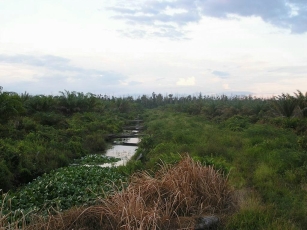 Draining peat swamps for agriculture and timber extraction has also become one of the biggest threats to forest ecosystems in Indonesia. Peat swamps are forests with waterlogged soils that prevent dead leaves and wood from fully decomposing. Over time, the dead material creates a thick layer of acidic peat. In Indonesia, the two national parks with the highest densities of wild orangutans, Sebangau and Tanjung Puting, are mainly peat swamp forests.
Draining peat swamps for agriculture and timber extraction has also become one of the biggest threats to forest ecosystems in Indonesia. Peat swamps are forests with waterlogged soils that prevent dead leaves and wood from fully decomposing. Over time, the dead material creates a thick layer of acidic peat. In Indonesia, the two national parks with the highest densities of wild orangutans, Sebangau and Tanjung Puting, are mainly peat swamp forests.
Peat swamps act like sponges, absorbing large amounts of rain and river water during the wet season, controlling floods and runoff, and releasing it slowly during the dry season. Unfortunately, large-scale conversion of peat swamps for agriculture is occurring in Indonesia, making these areas susceptible to fire. While fire doesn't normally spread in the moist, closed-canopy environment of undisturbed peat swamp forests, dry peat smolders for long periods and burns down to the water table. In addition, peat swamp forest trees aren't naturally adapted to fire and have high post-fire mortality (Harrison et. al., 2009).
Protecting forests in Indonesia and Malaysia is important for the future of both orangutans and people, but protecting ecosystems doesn't just mean protecting the trees and large mammals that live there. It means protecting the millions of species that work together, in intricate, tightly-woven cycles.
When humans alter ecosystems, the large mammals often disappear first. Their disappearance have a devastating effect on the forest ecosystem and other species, including species of fruit that rely on large mammals to digest and disperse them. The disappearance of large carnivores can cause herbivore populations to surge. When there are too many herbivores and not enough plants, the density of diversity of plants also suffer.
The loss of large herbivores like orangutans can have the opposite effect of exploding populations of plants, small herbivores like rodents, and their predators, such as snakes (McCauley et. al., 2006). But while orangutans, leopards, tigers, elephants, rhinos, and other charismatic animals play an important role in the forest ecosystem, their role is no more important than that of the millions of species of birds, reptiles, insects, plants, fungi and other species that work together to provide the services that we all depend on for our survival.
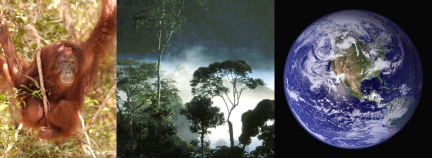 The word "orangutan" comes from the Malay terms "orang" (person) and "hutan" (forest). The future of the orangutan is linked to the future of its rainforest home. While forest fires, logging, and habitat destruction for agriculture are currently the most immediate threats to orangutans, but the long-term combined effects of these actions on the global climate will likely be far greater than today's challenges.
The word "orangutan" comes from the Malay terms "orang" (person) and "hutan" (forest). The future of the orangutan is linked to the future of its rainforest home. While forest fires, logging, and habitat destruction for agriculture are currently the most immediate threats to orangutans, but the long-term combined effects of these actions on the global climate will likely be far greater than today's challenges.
Trees and plants absorb and store carbon. Tropical forests in particular are incredibly carbon-rich. This is especially true of the peat swamps in Aceh and across Kalimantan in which orangutans live. However, deforestation and exploitation of buried organic matter in the form of fossil fuels is increasing the amount of CO2 in the atmosphere and changing the climate. Atmospheric CO2 concentrations have increased by 46% since 1750 (National Oceanic and Atmospheric Association, 2018). By the end of the century, the average global temperature is projected to rise by 3-5 degrees Celsius (World Meteorological Society, 2018). Protecting and restoring forests such as the orangutan's peat forest habitat is one of the most effective ways to mitigate the effects of climate change (Bastin et. al., 2019).
The effects of rising temperatures are already felt throughout the world. Greenland's glaciers are melting faster, and glaciers in most of the world are also retreating. Longer summers and earlier snowpack melts are increasing wildfires in the American West. Many species are changing the timing of their life histories, life cycles, and migration patterns to deal with seasonal changes. Costa Rica's Monteverde cloud forest, which depends on condensation from clouds for moisture, is experiencing more dry days. The golden toad that inhabits these forests could be the first documented terrestrial extinction caused by climate change (Pounds et. al., 1999).
As an archipelago of more than 17,000 islands with one of the world's highest rates of deforestation, Indonesia is one of the world's biggest contributors to climate change and one of the country's most adversely affected by it.
During El Nino years, dry season rainfall can be less than half of normal, and very severe El Nino years have seen huge fires devastate Indonesia's forests (Harrison et. al., 2009). Once thought to occur around once every seven years, there is evidence that climate change is increasing the frequency and severity of El Nino southern oscillations, with Indonesia experiencing drought conditions and corresponding forest fires in 1972-73, 1982-83, 1987, 1991-92, 1997-1998, 2002, 2006, 2009, and 2014-2015 (Yeager et. al., 2003). The results were devastating. Forest fires in 1982 and 1983 burned around 3.6 million hectares of forest in East Kalimantan alone (Leighton & Wirawan, 1986), and forest fires in 1997 and 1998, usually started by local farmers or plantation companies and exacerbated by drought conditions, destroyed at least 9.7 million hectares of forest throughout Indonesia, significantly affected 36 of the 45 major forest blocks in Kalimantan, and devastated the country's national parks (Case et. al., 2009; Yeager et. al., 2003). Thousands of orangutans likely died as the forests burned in 1997-98, with a survey in 2003 showing the wild population in the Sebangau area of central Kalimantan had decreased by 49% relative to 1996 (Suhuh & Saleh, 2007). Hundreds of adult orangutans were also killed by villagers as they fled and wandered into villages in search of food, and orangutan rehabilitation centers were inundated with orphaned babies and infants otherwise destined for the illegal pet trade (Barber & Schweithelm, 2010).
The amount of carbon dioxide that the fires released into the atmosphere is also concerning. During the 1997-98 fires, two million hectares of carbon-rich peat swamp forest burned, releasing 0.81-2.57 billion tonnes of carbon into the atmosphere (Page et. al., 2002; Rieley, 2002). The surface air temperature in Asia has already increased by 1-3 degrees over the last century, and annual precipitation decreased by two to three percent across Indonesia over the same period (Case et. al., 2009). The increased frequency of El Nino-impacted forest fires could create a positive feedback loop where increased burning increases atmospheric CO2, which raises temperatures and increases the frequency and severity of ENSO events and future fires (Harrison et. al., 2009). Additionally, forests that burn once are more susceptible to future fires. This is because reduced canopy cover reduces humidity levels in the forest. As a result, biomass dries faster, creating more fuel (Yeager et. al., 2003).
Intensifying drought conditions and more frequent forest fires are some of the most immediate threats to orangutans and their forest habitat, but the long-term effects of fires on forest quality and other effects of climate change are also concerning. Orangutans feed on up to 400 different types of fruit. Their very survival depends on the amount of fruit and other forest products that can sustain them. However, studies show that there are fewer species of tree and less fruit after forest fires (Suhud & Saleh, 2007; Yeager et. al., 2003).
Warming temperatures and changes in precipitation and seasonality will likely affect fruiting trees and the seasonal activities of the forests' flora and fauna (Saleh, 2009). Temperatures in Asia are expected to increase by between 0.72-3.92 degrees between now and the end of the century, and the annual monsoon in Indonesia could be delayed by 30 days every year (Chase et. al., 2009). A longer, more severe dry season will likely reduce the abundance of fruits (Saleh, 2009). Although orangutans can store fat during periods of low fruit availability, longer periods will force orangutans to rely more heavily on low quality fall back foods like bark and struggle to maintain their body weight (Knott, 1998).
This change may also affect orangutan reproduction because females are less likely to conceive during periods of low fruit abundance (Saleh, 2009). In addition, orangutan ranging patterns and social systems will change as orangutans adjust their behavior and locations to deal with the scarcity of suitable forest foods (Suhud & Saleh, 2007).
Climate change is one of the most challenging and controversial threats facing the planet. Conserving tropical rainforests is one of the most effective ways to decrease the amount of carbon released into the atmosphere, and the only way of securing the future of the orangutan species.
Forest fires are a usual occurrence in the parts of Indonesia and Malaysia where local people still practice traditional slash-and-burn agriculture. Under normal circumstances, however, the moisture contained within primary rainforests would control such fires, and the practice has coexisted with healthy orangutan populations for centuries.
In recent years, the frequency and intensity of forest fires have increased, and the results have been catastrophic for rainforests, orangutans, humans and for the economy of Indonesia, Malaysia, and the wider Southeast Asian area. Huge areas of forest have been destroyed by these fires.
In 1997 and 1998, forest fires raged throughout 4.7 million hectares of Indonesia’s tropical forests, damaging 36 of the 45 major forest blocks in Kalimantan, adversely affecting 19 national parks and reserves, and destroying habitat for and killing thousands of orangutans (Yeager et. al., 2003; Harrison et. al., 2009). Exacerbated by the El Nino weather phenomenon, which causes severe droughts throughout South East Asia, the fires were set by palm oil companies, plantation owners and small-scale farmers to clear land, and even arsonists using fire in land tenure disputes. Poor logging practices, which have seen a buildup of fuel loads in logging concessions, and the draining of peat swamp forests, added to the severity of the fires. After raging for nearly a year, it is likely that one-third of the existing orangutan population perished, and rehabilitation centers in Borneo and Sumatra were full to capacity with orangutans rescued from burning forests, many with serious burns and respiratory problems.
It was not just animals that suffered. An estimated 20 million people in Indonesia were suffering from respiratory problems by 1998, and between 19,800 and 48,100 premature mortalities were attributed to the fires. It’s estimated that the economic loss to Indonesia was US$20.1 billion dollars (Harrison et. al., 2009).
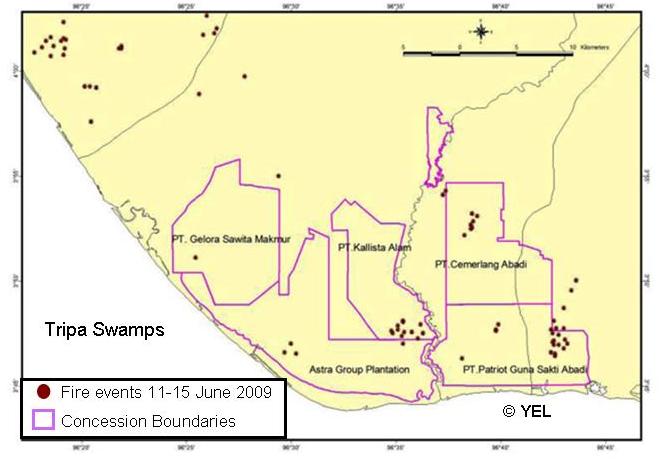 Unfortunately, since 1997, fires in Borneo and Sumatra have been an almost annual occurrence, as rapid palm oil expansion, continued logging and the draining of peat swamp forests continues unabated. With the frequency of the El Nino climatic oscillation increasing, fire prevention is an increasingly important feature of orangutan conservation. In 2009, fires were detected in the Tripa peat swamps of Aceh in Sumatra, an area currently battling palm oil expansion, and the three biggest protected areas in Central Kalimantan, Sebangu National Park, Tanjung Puting National Park, and the Lamandau Nature Reserve, which have a combined total of 13,000 orangutans, were all badly damaged by fires.
Unfortunately, since 1997, fires in Borneo and Sumatra have been an almost annual occurrence, as rapid palm oil expansion, continued logging and the draining of peat swamp forests continues unabated. With the frequency of the El Nino climatic oscillation increasing, fire prevention is an increasingly important feature of orangutan conservation. In 2009, fires were detected in the Tripa peat swamps of Aceh in Sumatra, an area currently battling palm oil expansion, and the three biggest protected areas in Central Kalimantan, Sebangu National Park, Tanjung Puting National Park, and the Lamandau Nature Reserve, which have a combined total of 13,000 orangutans, were all badly damaged by fires.
Ancrenaz, M., Dabek, L. & O'Neil, S. (2007). The Costs of Exclusion: Recognizing a Role for Local Communities in Biodiversity Conservation. PLoS Biol 5(11).
Bastin et. al. (05 Jul 2019). The global tree restoration potential. Science, Vol. 365, Issue 6448, pp. 76-79.
Bolin, B. & Cook, R.B. (1983). The major biogeochemical cycles and their interactions. John Wiley & Sons, UK.
Bradshaw C.J.A., Sodhi, N.S., Peh, K.S.H. & Brook, B.W. (2007). Global evidence that deforestation amplifies flood risk and severity in the developing world. Global Change Biology, Vol 13, 11, pp. 2379-2395.
Case M., Ardiansyah, F. & Spector, E. (2009). Climate change in Indonesia: implications for humans and nature. WWF Indonesia.
Barber, C.V. & Schweithelm, J. (2010). Trial by Fire. World Resources Institute.
Dahdough-Guebas, F., Jayatissa, L.P., Di Nitto, D., Bosire, J.O., Lo Seen, D. & Koedam, N. (2005). How effective were mangroves as a defense against the recent tsunami? Current Biology, Vol 15, 12, pp. 443-447.
Falkowski, P., Scholes, R.J., Boyle, E., Canadell, J., Canfield, D., Elser, J., Gruber, N., Hibbard, K., Hogberg, P., Linder, S., Mackenzie, F.T., Moore, B., Pedersen, T., Rosenthal, Y., Seitzinger, S., Smetacek, V. & Steffen, W. (2000). The global carbon cycle: a test of our knowledge of earth as a system. Science, Vol 290, No 5490, pp. 291-296.
Galdikas, B. (2009). The climate of Indonesia. Orangutan Foundation International.
Harrison, M.E., Page, S.E. & Limin, S.H. (2009). The global impact of Indonesian forest fires. Biologist, Vol 56, 3, pp. 156-163.
Knott, C. (1998). Changes in orangutan caloric intake, energy balance & ketones in response to fluctuating fruit availability. International Journal of Primatology, Vol 19, No 6, pp. 1061-1079.
McCauley, D.J., Keesing, F., Young, T.P., Allan, B.F. & Pringle, R.M. (2006). Indirect effects of large harbivores on snakes in an African savanna.Ecology, 87 (10), pp. 2657-63.
Mongabay (2006). Saving orangutans in Borneo. Mongabay.com.
National Oceanic and Atmospheric Association. NOAA Research News. (May 30, 2018). https://research.noaa.gov/article/ArtMID/587/ArticleID/2359/NOAA%E2%80%99s-greenhouse-gas-index-up-41-percent-since-1990
Page, S.E., Siegert, F., Rieley, J.O., Boehm, H-D.V., Jaya, A. & Limin, S. (2002). The amount of carbon released from peat and forest fires in Indonesia. Nature, Vol 420, pp. 61-65.
Pimental, D., Harvey, C., Resosudarmo, P., Sinclair, K., Kurz, D., McNair, M., Crist, S., Shpritz, L., Fitton, L., Saffouri, R. & Blair, R. (1995). Environmental and economic costs of soil erosion and conservation benefits. Science, Vol 267, No. 5201, pp. 1117-1123.
Pimental D. & Kounang N. (1998). Ecology of soil erosion in ecosystems. Ecosystems, 1. pp. 416-426.
Pounds, J.A., Fogden, M.P.L. & Campbell, J.H. (1999). Biological response to climate change on a tropical mountain. Nature, Vol 398, pp. 611-615.
Pulp Mill Watch. (2007). Pulp Mill Watch Factsheet: Indonesia.
Rieley J. (2002). Kalimantan tropical peat swamp forest project. Orang Utan Tropical Peatland Project Press Release.
Saleh, C. (2009). Climate change and orangutans. WWF Indonesia.
Sekercioglu C.H. (2010). Ecosystem functions and services. In Sodhi, N.S. & Ehrlich, P.R.,editors, Conservation biology for all. Oxford UniversityPress, UK.
Stadtmueller, T. (1990). Soil erosion in east Kalimantan. Indonesian-German Forestry Project.
Leighton, M. and N. Wirawan. (1986). Catastrophic drought and fire in Borneo tropical rain forest associated with the 1982-1983 El Niño Southern Oscillation event. In G.T. Prance, editor, Tropical rain forest and the world atmosphere. Westview Press, Boulder Colorado, USA, pp 75-102.
Yeager, C.P., Marshall, A.J., Stickler, C.M. & Chapman, C.A. (2003). Effects of fires on peat swamp and lowland diptercarp forests in Kalimantan, Indonesia. Tropical Biodiversity, Vol 8, pp. 121-138.
World Meteorological Society. (2018). The State of the Global Climate in 2018.